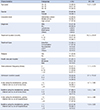1. Statistics Korea. Cause of death statistics in Korea 2014 [Internet]. Accessed September 23, 2015. Available from:
http://kostat.go.kr.
2. Korean Association for Children with Leukemia and Cancer. Complete mastery with 80 questions and answers based on childhood cancer [Internet]. Accessed December 9, 2013. Available from:
http://www.soaam.or.kr.
3. Russell HV, Okcu MF, Kamdar K, Shah MD, Kim E, Swint JM, et al. Algorithm for analysis of administrative pediatric cancer hospitalization data according to indication for admission. BMC Med Inform Decis Mak. 2014; 14:88.

4. Zupanec S, Tomlinson D. Leukemia. In : Tomlinson D, Kline NE, editors. Pediatric oncology nursing: advanced clinical handbook. Berlin: Springer-Verlag Berlin Heidelberg;2010. p. 2–32.
5. Lanzkowsky P. Manual of pediatric hematology and oncology. London: Elsevier;2011.
6. Baggott C, Dodd M, Kennedy C, Marina N, Matthay KK, Cooper BA, et al. Changes in children's reports of symptom occurrence and severity during a course of myelosuppressive chemotherapy. J Pediatr Oncol Nurs. 2010; 27:307–315.

7. Walker AJ, Gedaly-Duff V, Miaskowski C, Nail L. Differences in symptom occurrence, frequency, intensity, and distress in adolescents prior to and one week after the administration of chemotherapy. J Pediatr Oncol Nurs. 2010; 27:259–265.

8. Tarokh L, Carskadon MA. Sleep in adolescents. In : Stickgold R, Walker MP, editors. The neuroscience of sleep. London: Academic Press;2009. p. 70–77.
9. Kim YJ, Kim GJ, Kim JH, Lee MH. The study on the current status of Korean childrens and youths rights III: the 2013 statistics of the survey on rights of children and youths. Seoul: National Youth Policy Institute;2013.
10. Linder LA, Christian BJ. Characteristics of the nighttime hospital bedside care environment (sound, light, and temperature) for children with cancer. Cancer Nurs. 2011; 34:176–184.

11. Herbert AR, de Lima J, Fitzgerald DA, Seton C, Waters KA, Collins JJ. Exploratory study of sleeping patterns in children admitted to hospital. J Paediatr Child Health. 2014; 50:632–638.

12. Park MJ, Yoo JH, Cho BW, Kim KT, Jeong WC, Ha M. Noise in hospital rooms and sleep disturbance in hospitalized medical patients. Environ Health Toxicol. 2014; 29:e2014006.

13. Chokroverty S. Overview of sleep & sleep disorders. Indian J Med Res. 2010; 131:126–140.
14. Lewandowski AS, Ward TM, Palermo TM. Sleep problems in children and adolescents with common medical conditions. Pediatr Clin North Am. 2011; 58:699–713.

15. Lazaratou H, Soldatou A, Dikeos D. Medical comorbidity of sleep disorders in children and adolescents. Curr Opin Psychiatry. 2012; 25:391–397.

16. Sohn SY. Factors affecting suicidal ideation, suicidal plan and suicidal attempt in Korean adolescents. J Korea Acad Ind Coop Soc. 2014; 15:1606–1614.

17. Lee HS. Factors of sleep disturbance and sleep patterns according to age in older hospitalized women patients. J Korean Acad Fundam Nurs. 2011; 18:186–194.
18. Kim RY, Park H. Fatigue, sleep disturbance, and quality of life among breast cancer patients receiving radiotherapy. Korean J Adult Nurs. 2015; 27:188–197.

19. Hong SS, Park HR, Kim KS, Choi SH. Late effects, social adjustment, and quality of life in adolescent survivors of childhood leukemia. J Korean Acad Nurs. 2014; 44:55–63.

20. Hong SS, Park HR. Predictors of resilience in adolescents with leukemia. J Korean Acad Nurs. 2015; 45:595–603.

21. Snyder-Halpern R, Verran JA. Instrumentation to describe subjective sleep characteristics in healthy subjects. Res Nurs Health. 1987; 10:155–163.

22. Park HR. The sleep pattern and sleep disturbing factor according to the transplantation stage of patient undergoing hemopoietic stem cell transplantation [dissertation]. Seoul: Catholic Univ.;2004.
23. Buysse DJ, Reynolds CF 3rd, Monk TH, Berman SR, Kupfer DJ. The Pittsburgh Sleep Quality Index: a new instrument for psychiatric practice and research. Psychiatry Res. 1989; 28:193–213.

24. Oh GH. A study on the factors influencing sleep-pattern of patients [dissertation]. Seoul: Ewha Womans Univ.;1998.
25. Kim EJ, Kang SG, Moon MS, Lim SW, Oh KS. Differential relations of depression, anxiety and sleep disturbances by gender in young adolescents. Korean J Psychosom Med. 2010; 18:62–71.
26. Graves JK, Jacob E. Pain, coping, and sleep in children and adolescents with sickle cell disease. J Child Adolesc Psychiatr Nurs. 2014; 27:109–120.

27. Kim HS, Oh EG. An explanatory model for sleep disorders in people with cancer. J Korean Acad Nurs. 2011; 41:460–470.

28. Zupanec S, Jones H, Stremler R. Sleep habits and fatigue of children receiving maintenance chemotherapy for ALL and their parents. J Pediatr Oncol Nurs. 2010; 27:217–228.

29. Yun HJ. Health impaired children's participation experience of hospital school programs as perceived by mothers. J Korean Public Health Nurs. 2015; 29:515–527.

30. Yoder JC, Staisiunas PG, Meltzer DO, Knutson KL, Arora VM. Noise and sleep among adult medical inpatients: far from a quiet night. Arch Intern Med. 2012; 172:68–70.









 PDF
PDF ePub
ePub Citation
Citation Print
Print



 XML Download
XML Download